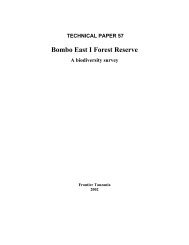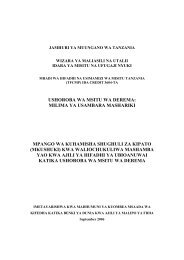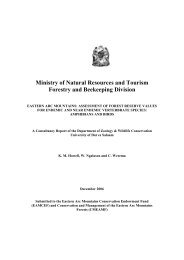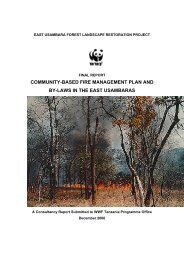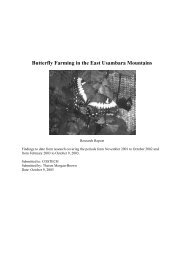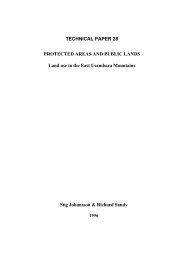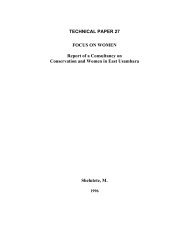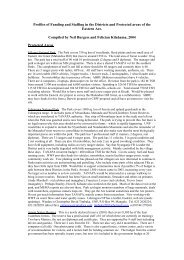Development of Sustainable Forest Use Strategies - Eastern Arc ...
Development of Sustainable Forest Use Strategies - Eastern Arc ...
Development of Sustainable Forest Use Strategies - Eastern Arc ...
You also want an ePaper? Increase the reach of your titles
YUMPU automatically turns print PDFs into web optimized ePapers that Google loves.
Stated Economic <strong>Use</strong>s<br />
Apart from being reserved lands, which may be used in accordance to the <strong>Forest</strong><br />
Act, 2002, many parts <strong>of</strong> the <strong>Eastern</strong> <strong>Arc</strong> Mountain forests are hazardous lands<br />
because they have steep slopes. The Land Act states that, “hazardous land is land<br />
the development <strong>of</strong> which is likely to pose danger to life or lead to the degradation <strong>of</strong><br />
or environmental destruction on that or contiguous land” and includes, among<br />
others, “land on slopes with a gradient exceeding any angle which the Minister [for<br />
the time being responsible for lands] shall, after taking account <strong>of</strong> proper scientific<br />
advice, specify” (URT, 1999:52). Being hazardous they cannot be put to any<br />
economic use except, perhaps for eco-tourism, including mountain or rock climbing,<br />
but this is not stated in the Act. No stated uses and hence no degree allowable.<br />
3.1.3.3 National Water Policy <strong>of</strong> 2002<br />
The National Water Policy (NWP) identifies water resources as rivers, lakes,<br />
wetlands, springs, reservoirs and groundwater aquifers (MWLD, 2002:9) and<br />
acknowledges that water is critical to ecological systems and to the maintenance <strong>of</strong><br />
the environment (p.33).<br />
Stated Economic <strong>Use</strong>s<br />
NWP lists types <strong>of</strong> water use as domestic and for supplying livestock, agriculture,<br />
industry, mining and energy production, fisheries, sustenance <strong>of</strong> the<br />
environment/ecosystem, wildlife and tourism, forestry and beekeeping and<br />
navigation. Water uses are prioritized. First priority goes to basic human needs.<br />
“Water for the environment to protect the ecosystems that underpin our water<br />
sources, now and in the future” is given second priority. Other uses following after<br />
these two are subject to social and economic criteria. Based on the water resources<br />
listed above, in most cases water is accessed by users when it is already outside the<br />
<strong>Eastern</strong> <strong>Arc</strong> Mountain forests except for hydropower generation like in the case <strong>of</strong><br />
Kidatu and Kihansi.<br />
Degree <strong>of</strong> Allowable Economic <strong>Use</strong>s<br />
As far as NWP is concerned, there are no procedures and guidelines to ensure<br />
sustainability <strong>of</strong> ecological systems (MWLD, 2002:33). Therefore, no exact degree <strong>of</strong><br />
allowable use <strong>of</strong> water is stated. The policy states only that, “Water allocations and<br />
use shall be carried out considering the principles <strong>of</strong> sustainability so that the<br />
resources remain viable for the use <strong>of</strong> the present and future generations” (p.30).<br />
3.1.3.4 National Environmental Policy <strong>of</strong> 1997<br />
The National Environmental Policy (NEP) interprets the term environment to include,<br />
among others, plant and animal life (VPO, 1997:1). This gives it a stake in the affairs<br />
<strong>of</strong> the <strong>Eastern</strong> <strong>Arc</strong> Mountain forests. The policy aims at, among others, ensuring<br />
sustainable and equitable use <strong>of</strong> resources for meeting the basic needs <strong>of</strong> the<br />
14



